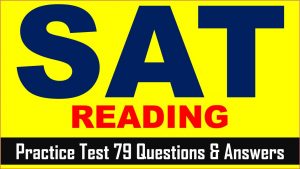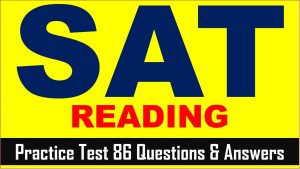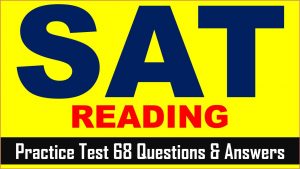SAT (Scholastic Assessment Test) is a standard test, used for taking admission to undergraduate programs of universities or colleges of the United States. SAT is developed and published by the College Board, an organization in the United States, administered by the Educational Testing Service. In this article of AKVTutorials, you will get SAT Practice Test 6 Answers | SAT 2024 Prep Online Classes AMBiPi.
SAT Reading Practice Passage
This passage is from Charlotte Brontë, The Professor, originally published in 1857.
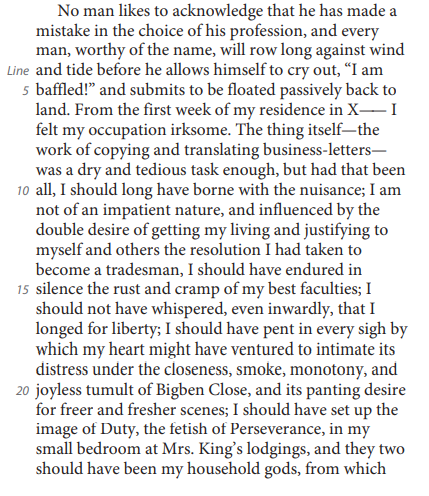
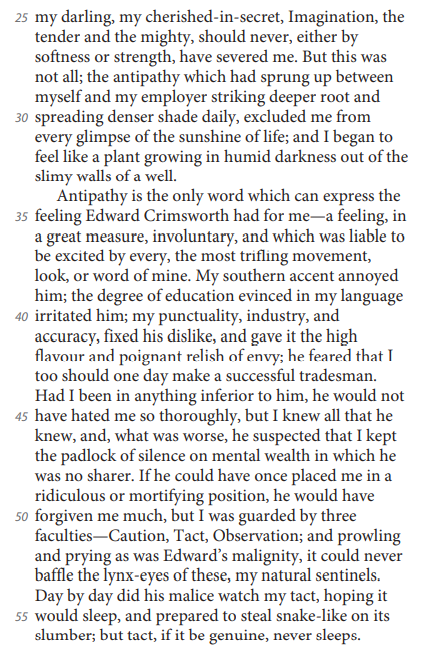
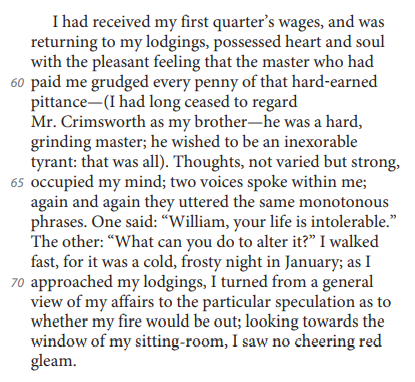
SAT Reading Comprehension Practice Test Questions
SAT Practice Test 6 Question No 1
Which choice best summarizes the passage?
Option A: A character describes his dislike for his new job and considers the reasons why.
Option B: Two characters employed in the same office become increasingly competitive.
Option C: A young man regrets privately a choice that he defends publicly.
Option D: A new employee experiences optimism, then frustration, and finally despair.
SAT Practice Test 6 Answer No 1
Show/Hide Answer
Option A :
The narrator admits that his job is “irksome” (line 7) and reflects on the reasons for his dislike. The narrator admits that his work is a “dry and tedious task” (line 9) and that he has a poor relationship with his superior: “the antipathy which had sprung up between myself and my employer striking deeper root and spreading denser shade daily excluded me from every glimpse of the sunshine of life” (lines 28-31).
Choices B, C, and D are incorrect because the narrator does not become increasingly competitive with his employer, publicly defend his choice of occupation, or exhibit optimism about his job.
SAT Practice Test 6 Question No 2
The main purpose of the opening sentence of the passage is to
Option A: establish the narrator’s perspective on a controversy.
Option B: provide context useful in understanding the narrator’s emotional state.
Option C: offer a symbolic representation of Edward Crimsworth’s plight.
Option D: contrast the narrator’s good intentions with his malicious conduct.
SAT Practice Test 6 Answer No 2
Show/Hide Answer
Option B :
The first sentence of the passage explains that people do not like to admit when they’ve chosen the wrong profession and that they will continue in their profession for a while before admitting their unhappiness. This statement mirrors the narrator’s situation, as the narrator admits he finds his own occupation “irksome” (line 7) but that he might “long have borne with the nuisance” (line 10) if not for his poor relationship with his employer.
Choice A is incorrect because the passage focuses on a nontraditional marriage proposal. Choice C is incorrect because the passage concludes without resolution to the question of whether Akira and Naomi will receive permission to marry. Choice D is incorrect because the passage repeatedly makes clear that for Chie, her encounter with Akira is momentous and unsettling, as when Akira acknowledges in line 73 that he has “startled” her.
SAT Practice Test 6 Question No 3
During the first paragraph, the narrator’s focus shifts from
Option A: recollection of past confidence to the acknowledgment of present self-doubt.
Option B: reflection on his expectations of life as a tradesman to his desire for another job.
Option C: a generalization about job dissatisfaction to the specifics of his situation.
Option D: evaluation of factors making him unhappy with the identification of alternatives.
SAT Practice Test 6 Answer No 3
Show/Hide Answer
Option C :
The first paragraph shifts from a general discussion of how people deal with choosing an occupation they later regret (lines 1-6) to the narrator’s description of his dissatisfaction with his occupation (lines 6-33).
Choices A, B, and D are incorrect because the first paragraph does not focus on the narrator’s self-doubt, his expectations of life as a tradesman, or his identification of alternatives to his current occupation.
SAT Practice Test 6 Question No 4
The references to “shade” and “darkness” at the end of the first paragraph mainly have which effect?
Option A: They evoke the narrator’s sense of dismay.
Option B: They reflect the narrator’s sinister thoughts.
Option C: They capture the narrator’s fear of confinement.
Option D: They reveal the narrator’s longing for rest.
SAT Practice Test 6 Answer No 4
Show/Hide Answer
Option A :
In lines 27-33, the narrator is describing the hostile relationship between him and his superior, Edward Crimsworth. This relationship causes the narrator to feel like he lives in the “shade” and in “humid darkness.” These words evoke the narrator’s feelings of dismay toward his current occupation and his poor relationship with his superior—factors that cause him to live without “the sunshine of life.
Choices B, C, and D are incorrect because the words “shade” and “darkness” do not reflect the narrator’s sinister thoughts, his fear of confinement, or his longing for rest.
SAT Practice Test 6 Question No 5
The passage indicates that Edward Crimsworth’s behavior was mainly caused by his
Option A: impatience with the narrator’s high spirits.
Option B: scorn of the narrator’s humble background.
Option C: indignation at the narrator’s rash actions.
Option D: jealousy of the narrator’s apparent superiority.
SAT Practice Test 6 Answer No 5
Show/Hide Answer
Option D :
The narrator states that Crimsworth dislikes him because the narrator may “one day make a successful tradesman” (line 43). Crimsworth recognizes that the narrator is not “inferior to him” but rather more intelligent, someone who keeps “the padlock of silence on mental wealth which [Crimsworth] was no sharer” (lines 44-48). Crimsworth feels inferior to the narrator and is jealous of the narrator’s intellectual and professional abilities.
Choices A and C are incorrect because the narrator is not described as exhibiting “high spirits” or “rash actions,” but “Caution, Tact, [and] Observation” (line 51). Choice B is incorrect because the narrator’s “humble background” is not discussed.
SAT Practice Test 6 Question No 6
The passage indicates that when the narrator began working for Edward Crimsworth, he viewed Crimsworth as a
Option A: harmless rival.
Option B: sympathetically.
Option C: perceptive judge.
Option D: demanding mentor.
SAT Practice Test 6 Answer No 6
Show/Hide Answer
Option B :
Lines 61-62 state that the narrator “had long ceased to regard Mr. Crimsworth as my brother.” In these lines, the term “brother” means friend or ally, which suggests that the narrator and Crimsworth were once friendly toward one another.
Choices A, C, and D are incorrect because the narrator originally viewed Crimsworth as a friend, or ally, and later as a hostile superior; he never viewed Crimsworth as a harmless rival, perceptive judge, or demanding mentor.
SAT Practice Test 6 Question No 7
Which choice provides the best evidence for the answer to the previous question?
Option A: Lines 28-31 (“the antipathy… life”)
Option B: Lines 38-40 (“My southern… irritated him”)
Option C: Lines 54-56 (“Day… slumber”)
Option D: Lines 61-62 (“I had… brother”)
SAT Practice Test 6 Answer No 7
Show/Hide Answer
Option D :
In lines 61-62, the narrator states that he once regarded Mr. Crimsworth as his “brother.” This statement provides evidence that the narrator originally viewed Crimsworth as a sympathetic ally.
Choices A, B, and C do not provide the best evidence for the claim that Crimsworth was a sympathetic ally. Rather, choices A, B, and C provide evidence of the hostile relationship that currently exists between the narrator and Crimsworth.
SAT Practice Test 6 Question No 8
At the end of the second paragraph, the comparisons of abstract qualities to a lynx and a snake mainly have the effect of
Option A: contrasting two hypothetical courses of action.
Option B: conveying the ferocity of a resolution.
Option C: suggesting the likelihood of an altercation.
Option D: illustrating the nature of an adversarial relationship.
SAT Practice Test 6 Answer No 8
Show/Hide Answer
Option D :
In lines 48-53, the narrator states that he exhibited “Caution, Tact, [and] Observation” at work and watched Mr. Crimsworth with “lynx-eyes.” The narrator acknowledges that Crimsworth was “prepared to steal snake-like” if he caught the narrator acting without tact or being disrespectful toward his superiors (lines 53-56). Thus, Crimsworth was trying to find a reason to place the narrator “in a ridiculous or mortifying position” (lines 49-50) by accusing the narrator of acting unprofessionally. The use of the lynx and snake serves to emphasize the narrator and Crimsworth’s adversarial, or hostile, relationship.
Choices A and B are incorrect because the description of the lynx and snake does not contrast two hypothetical courses of action or convey a resolution. Choice C is incorrect because while lines 48-56 suggest that Crimsworth is trying to find a reason to fault the narrator’s work, they do not imply that an altercation or heated dispute, between the narrator and Crimsworth, is likely to occur.
SAT Practice Test 6 Question No 9
The passage indicates that, after a long day of work, the narrator sometimes found his living quarters to be
Option A: treacherous.
Option B: dreary.
Option C: predictable.
Option D: intolerable.
SAT Practice Test 6 Answer No 9
Show/Hide Answer
Option B :
Lines 73-74 state that the narrator noticed there was no “cheering red gleam” of fire in his sitting-room fireplace. The lack of a “cheering,” or comforting, fire suggests that the narrator sometimes found his lodgings to be dreary or bleak.
Choices A and D are incorrect because the narrator does not find his living quarters to be treacherous or intolerable. Choice C is incorrect because while the narrator is walking home he speculates about the presence of a fire in his sitting-room’s fireplace (lines 69-74), which suggests that he could not predict the state of his living quarters.
SAT Practice Test 6 Question No 10
Which choice provides the best evidence for the answer to the previous question?
Option A: Lines 17-21 (“I should… scenes”)
Option B: Lines 21-23 (“I should… lodgings”)
Option C: Lines 64-67 (“Thoughts… phrases”)
Option D: Lines 68-74 (“I walked… gleam”)
SAT Practice Test 6 Answer No 10
Show/Hide Answer
Option D :
In lines 68-74, the narrator states that he did not see the “cheering” glow of a fire in his sitting-room fireplace. This statement provides evidence that the narrator views his lodgings as dreary or bleak.
Choices A, B, and C do not provide the best evidence that the narrator views his lodgings as dreary. Choices A and C are incorrect because they do not provide the narrator’s opinion of his lodgings, and choice B is incorrect because lines 21-23 describe the narrator’s lodgings only as “small.”

